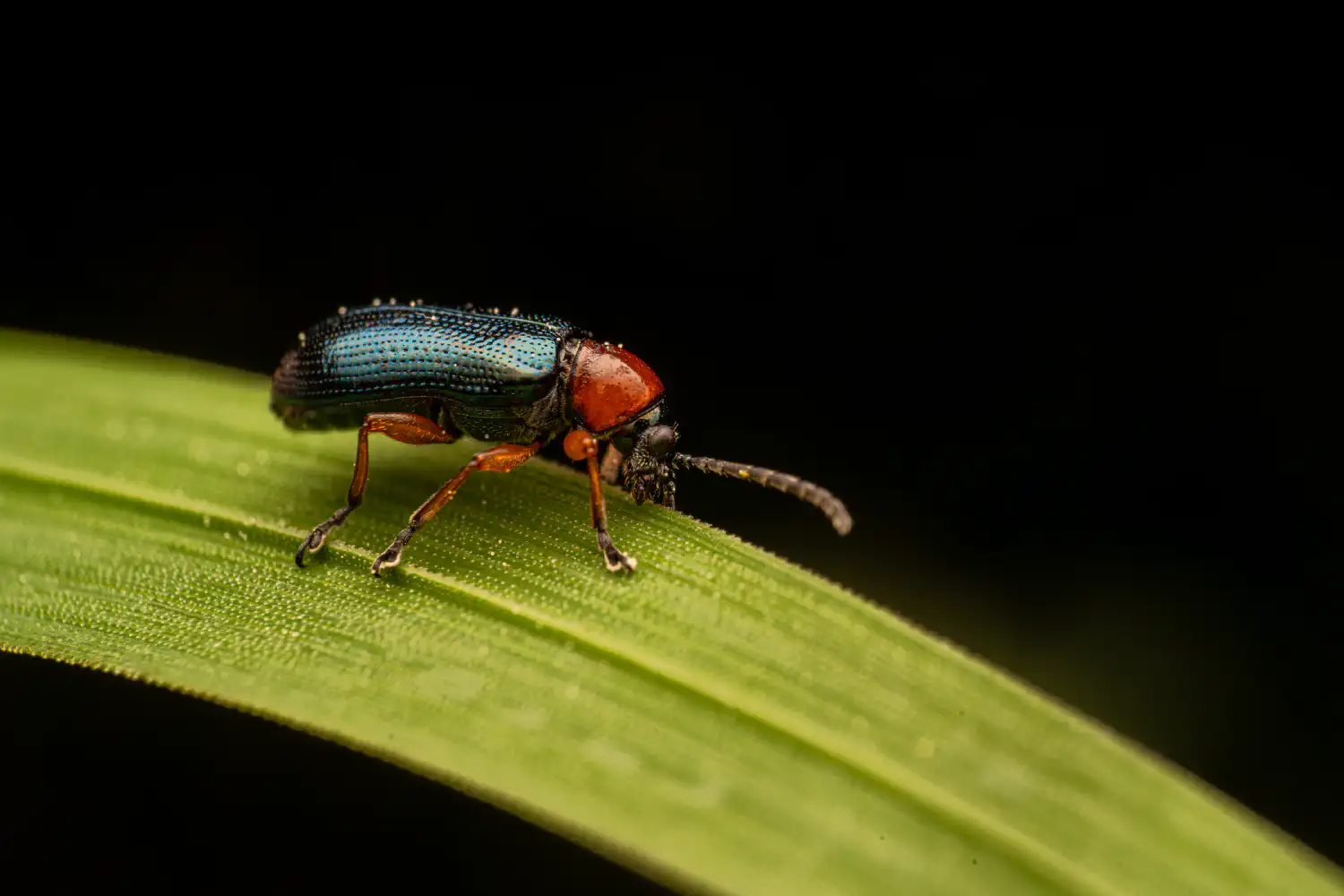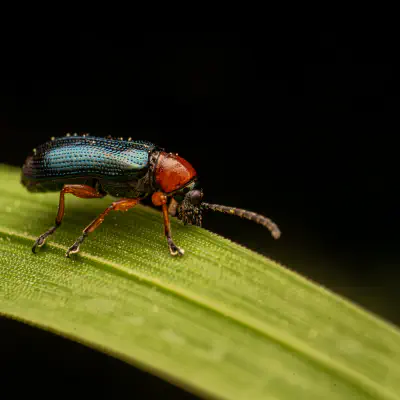Oulema melanopus Lat. “Oulema melanopus“
The cereal leaf beetle (Oulema melanopus) is a significant crop pest, described by Carl Linnaeus in 1758.
Life history
One generation of this beetle is produced a year. Adults feed before winter and spend most of their overwintering time in protected areas such as wind rows, crop stubble, and tree bark crevices. Adults mate once the temperature warms to above 9–10 degrees Celsius (or 44.6 degrees F) and females have a relatively long laying period (about 45–60 days), when they deposit eggs on the undersides of leaves. The larvae hatch in 7–15 days, and start the most damaging eating of the entire lifecycle. These larvae mature in 12–20 days. Larvae are the greatest threat to crops, as they eat the superficial layer of leaves, hindering the leaves’ photosynthetic potential. According to Kon, Zabik, Webster, and Leavitt, a chemical factor attracts the beetles to leaves, and that chemical factor is directly related to hydrophobicity. Pupation occurs in soil, with the adults emerging in 20–25 days, ready to start the cycle again. Eggs are cylindrical and round, about 0.9 mm long and 0.4 mm wide. Eggs are often laid along the midvein on the undersides of leaves. They are bright yellow at first and darken over time, and are partially black when the larvae emerge. The larva appears white or yellow, is hump-backed, and has a black head and six small legs. It has a defense mechanism in which it smears excrement on its body to mask its vibrant color and deter predators. This gives it a shiny black appearance, as opposed to yellow or white. Adults, on average, are about 5 mm long and have dark-blue wing covers and red legs. Their thoraces range in color from red to orange to reddish brown. The biggest distinction between male and female O. melanopus is the difference in shape of the first abdominal segment. The male’s segment is more narrowly rounded and flat or concave, and it is more broadly rounded and convex in the female. Pupas are rarely seen in fields, as they are dormant at that time. Pupae are about 5 mm in length and are yellow, also darkening with time.
Habitat
O. melanopus is native to Europe and Asia, but it has become much more common in the world. In North America, it was first spotted in Berrien County, Michigan, in 1962. Since then, it has spread through the Midwest to the East Coast, and is making its way westward. Significant populations are found in Virginia, North Carolina, Utah, Montana, North Dakota, and Missouri and Iowa. Environmental conditions such as temperature and humidity drastically affect the O. melanopus population for that year. A cold spring favors the host plant, whereas a warm spring favors the leaf beetle. An increase in the general temperature of the planet may allow O. melanopus to spread into Canada. More recent surveys have shown that O. melanopus has indeed arrived in Canada; in 2006, it was present in 11.1% of fields, and in 2009, in 33.3% of fields in southern Alberta. Locally, adults spread to the exterior of fields during their overwinter. Larvae tend to stay on the outside of crop fields, but are also found in the center. Local populations are never homogenously distributed, hotspots and empty places occur in each field.
Food
O. melanopus consumes nearly all cereal crops, but has a strong affinity for oats, barley, and rye, and its favorite host is wheat. Alternatives are corn, sorghum, and sudangrass for adults, and wild oats, quackgrass, timothy, canary grass, reed canary grass, annual and perennial ryegrass, foxtail, orchard grass, wild rye, smooth brome, and fescues for the whole lifespan. The physical symptoms of the plant caused by them are thin, long lines where the upper epidermis of the leaf has been eaten. Since the beetle is migratory when it eats, it is not consistent within a field. In Michigan, entire fields are rarely affected and the situation is most likely the same in the Midwest. A field of plants looks weathered and old, but is never completely destroyed. Damage is usually no more than 40% total. When a herbivore consumes a plant, it releases volatile organic compounds (VOCs). Because VOCs are a chemical signal that attract some predators, the female O. melanopus is repelled by the chemicals for her own and the safety of her progeny. Males are deterred, but do not change eating habits. To determine the eating habits of O. melanopus, scientists conducted an experiment using different media. They took agar gel infused with pea and barley extracts, and noted the resulting reaction. When used alone, both pea extract, which is not a desired food for the beetle, and barley extract, which is an alternate source, produced a weakening or halting of consumption. A combination of both, however, incited a small feeding response. Most likely, a secondary compound in barley incites an eating response, perhaps when a lack of desired food is present.
External links
Media related to Oulema melanopus at Wikimedia Commons Data related to Oulema melanopus at Wikispecies
Ancestry Graph
Further Information
„Oulema melanopus“ on wikipedia.org
„Oulema melanopus“ on iNaturalist.org
Copyright

This article uses material from the Wikipedia article Oulema melanopus the free encyclopedia Wikipedia which is released under Creative Commons Attribution-ShareAlike 4.0 International License). On Wikipedia a list of authors is available.

Little beings in print
Order our calendars and books today!
Compiled with love. Printed sustainably. Experience our little beings even more vividly in print. All our publications are available for a small donation.


